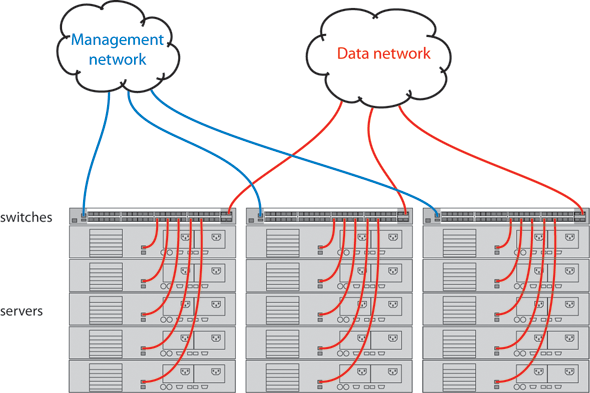Application client commands
CLI commands for client applications have added the
oobm keyword to allow you to specify that the outgoing request be issued from the OOBM interface. If you do not specify the
oobm keyword, the request will be issued from the appropriate in-band data interface. Command syntax is:
Telnet: |
|
Management and Configuration Guide |
TFTP: |
|
Management and Configuration Guide |
SNTP: |
|
Management and Configuration Guide |
TIMEP: |
|
Management and Configuration Guide |
RADIUS: |
|
Access Security Guide |
TACACS+: |
|
Access Security Guide |
DNS: |
|
Management and Configuration Guide |
Syslog: |
|
Management and Configuration Guide |
Ping: |
|
Management and Configuration Guide |
Traceroute: |
|
management and configuration guide |
Example:
The following example shows setup and use of network OOBM using the commands described above.
Assume that the figure below describes how you want to set up your data center.

Configure an IP address on the data network.
Verify that out-of-band management is enabled. (It is enabled by default.)
Configure an IP address on the management network.
Verify that the switch can communicate on both networks.
The CLI commands that follow would accomplish those tasks. (The first time through the process you might easily make the omission shown near the end of the example.)
switch 41# config switch 41(config)# vlan 1 switch 41(vlan-1)# ip address 10.1.129.7/20 Set up IP address on data network. switch 41(vlan-1)# end Exit back to manager context. switch 41# show oobm Look at default OOBM configuration. Global Configuration OOBM Enabled : Yes OOBM Port Type : 10/100TX OOBM Interface Status : Up Defaults look appropriate. OOBM Port : Enabled OOBM Port Speed : Auto switch 41# config switch 41(config)# oobm Go to OOBM context and switch 41(oobm)# ip address 10.255.255.41/24 add IP address and switch 41(oobm)# ip default-gateway 10.255.255.1 default gateway. switch 41(oobm)# end Exit back to manager context. switch 41# ping 10.1.131.44 Ping server in this rack (on data network). 10.1.131.44 is alive, time = 19 ms switch 41# ping 10.1.131.51 Ping server in adjacent rack. 10.1.131.51 is alive, time = 15 ms switch 41# ping 10.255.255.42 Ping switch in adjacent rack. The destination address is unreachable. Oops! It’s on the management network. switch 41# ping source oobm 10.255.255.42 Go through the management port 10.255.255.42 is alive, time = 2 ms and it works fine. switch 41#